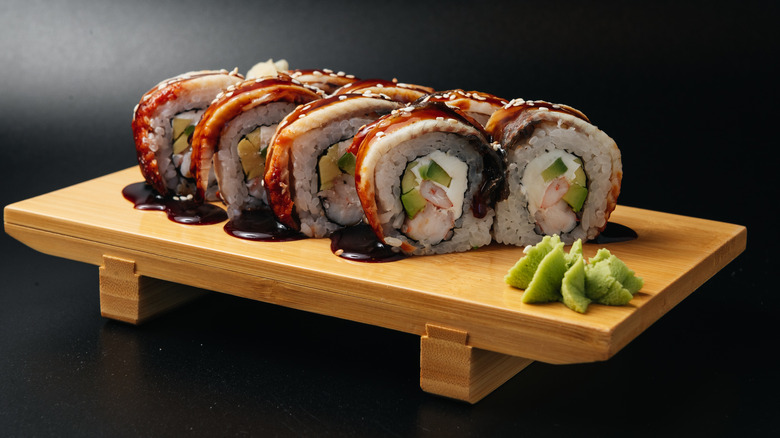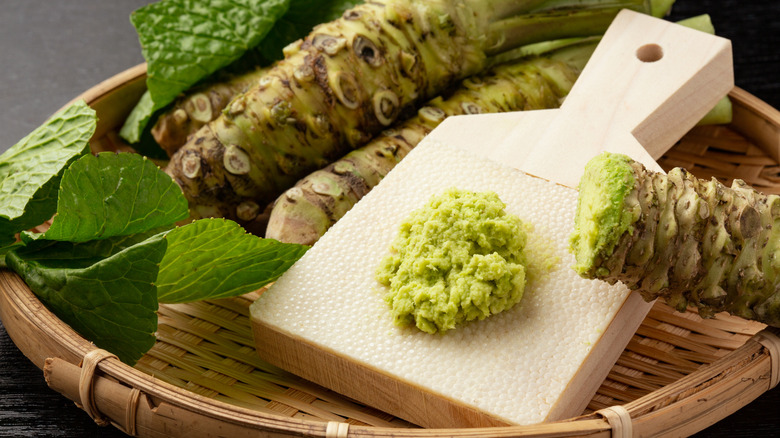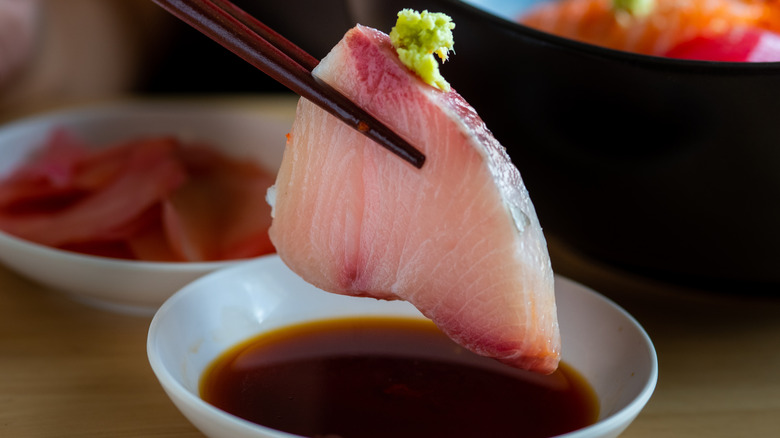How Wasabi Tricks Your Senses When Eating Sushi
A plate of sushi comes with more elements than just the fish itself — and each one is designed to serve a purpose that ultimately makes those sticky morsels of rice, vegetables, and seafood come together. Little bowls of soy sauce meant for dipping are packed with amino acids that can add an umami depth to the flavor of your nigiri, sashimi, or maki, whereas the slivers of pink-colored pickled ginger are meant to cleanse your palate between eating two different pieces. That dollop of bright green wasabi also has a role to play: it lessens the piscine odor that often laces the raw fish topped onto sushi and sashimi.
Wasabi is the rhizome of Japanese horseradish, pulled from the Wasabia japonica plant from the Brassicaceae family and then grated into a thick paste, traditionally done so using the gritty surface of shark skin. The paste has a plant-like herbal flavor with just a hint of sweetness and lots of pungent heat that's not very different from mustard or horseradish.
While wasabi masks the fishy odor of raw seafood to make sushi more appetizing for the palate, it also brings out more nuanced flavors from the fish by counteracting its natural fattiness. The sweet spice of wasabi goes fabulously with the fat present in raw fish as well as the soy sauce it's served with, giving a simple-looking piece of sushi an utterly complex depth of flavor.
More reasons why wasabi is eaten with sushi
While wasabi enhances the flavor of sushi and masks the smell of raw seafood, there's even more to the green paste. Wasabi has been used in Japan for its medicinal properties for far longer than its culinary applications; the rhizome has even been mentioned in the country's oldest recorded book of medicinal plants, Honzo Wamyo. For one, wasabi contains isothiocyanates (the same compounds that give it its unique flavor) that may have anti-bacterial properties. Thanks to the ICTs, wasabi may help fight bacteria such as E. coli, Staphylococcus aureus, and H. pylori, thus lessening the risk of certain foodborne illnesses (via Healthline).
This is important when it comes to eating sushi as wasabi can mitigate the risk of food poisoning from any bacteria hiding in raw fish and seafood. In fact, wasabi was a vital ingredient in both China and Japan at a time when refrigeration was yet to be invented, where the pungent paste was paired with raw fish to kill any bacteria present in it and prevent food poisoning.
Although more human research is needed, the ICTs present in wasabi have also been seen to possibly have anti-inflammatory and cancer-fighting properties, all reasons why the plant and its paste have been consumed for centuries, particularly in foods with raw seafood such as sushi.
The proper way to eat sushi with wasabi
Wasabi is essential to sushi for both its odor-masking and flavor-boosting abilities as well as its anti-bacterial properties, but much like the other rules that govern the realm of proper sushi-eating, there are dos and don'ts on how to best eat this spicy paste. Although whisking wasabi into shoyu or soy sauce may seem like a good idea — wasabi joyu is a thing after all — it is not always the best thing to do.
Wasabi's flavor and aroma are what mask sushi's fishy smell and bring out its more refined flavors. When mixed with soy sauce, the flavor of both the umami liquid and the sweet, herbal, and spicy paste change as they are sullied with each other.
Instead, the best way to eat wasabi is to smear the paste onto the fish part of the sushi and then dip the piece into soy sauce. Although some recommend smearing wasabi on one side of the sushi and then flipping it over and dipping the other side into soy sauce, many chefs have since said that sushi should be dipped nori aka seaweed or fish side first.
No matter how you choose to go about it, be sure to only use a pea-sized amount of wasabi in each piece though — you don't want its pungency to overpower the delicate balance of rice and fish.



